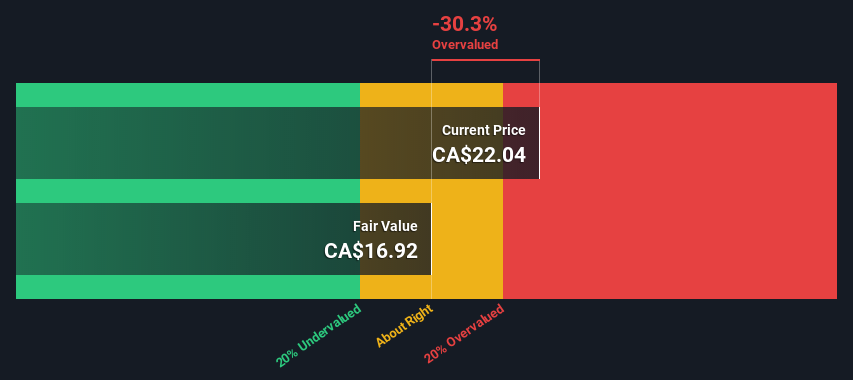- Canada
- /
- Oil and Gas
- /
- TSX:GEI
Are Gibson Energy Inc. (TSE:GEI) Investors Paying Above The Intrinsic Value?

Key Insights
- Gibson Energy's estimated fair value is CA$16.92 based on 2 Stage Free Cash Flow to Equity
- Gibson Energy is estimated to be 30% overvalued based on current share price of CA$22.04
- Our fair value estimate is 33% lower than Gibson Energy's analyst price target of CA$25.07
Today we'll do a simple run through of a valuation method used to estimate the attractiveness of Gibson Energy Inc. (TSE:GEI) as an investment opportunity by projecting its future cash flows and then discounting them to today's value. We will take advantage of the Discounted Cash Flow (DCF) model for this purpose. It may sound complicated, but actually it is quite simple!
Remember though, that there are many ways to estimate a company's value, and a DCF is just one method. For those who are keen learners of equity analysis, the Simply Wall St analysis model here may be something of interest to you.
Check out our latest analysis for Gibson Energy
The Method
We use what is known as a 2-stage model, which simply means we have two different periods of growth rates for the company's cash flows. Generally the first stage is higher growth, and the second stage is a lower growth phase. In the first stage we need to estimate the cash flows to the business over the next ten years. Where possible we use analyst estimates, but when these aren't available we extrapolate the previous free cash flow (FCF) from the last estimate or reported value. We assume companies with shrinking free cash flow will slow their rate of shrinkage, and that companies with growing free cash flow will see their growth rate slow, over this period. We do this to reflect that growth tends to slow more in the early years than it does in later years.
A DCF is all about the idea that a dollar in the future is less valuable than a dollar today, so we need to discount the sum of these future cash flows to arrive at a present value estimate:
10-year free cash flow (FCF) forecast
| 2023 | 2024 | 2025 | 2026 | 2027 | 2028 | 2029 | 2030 | 2031 | 2032 | |
| Levered FCF (CA$, Millions) | CA$334.4m | CA$318.7m | CA$254.5m | CA$225.9m | CA$237.2m | CA$220.9m | CA$211.5m | CA$206.3m | CA$203.8m | CA$203.2m |
| Growth Rate Estimate Source | Analyst x5 | Analyst x5 | Analyst x2 | Analyst x1 | Analyst x1 | Est @ -6.86% | Est @ -4.27% | Est @ -2.46% | Est @ -1.20% | Est @ -0.31% |
| Present Value (CA$, Millions) Discounted @ 10% | CA$303 | CA$261 | CA$189 | CA$152 | CA$144 | CA$122 | CA$106 | CA$93.3 | CA$83.5 | CA$75.3 |
("Est" = FCF growth rate estimated by Simply Wall St)
Present Value of 10-year Cash Flow (PVCF) = CA$1.5b
After calculating the present value of future cash flows in the initial 10-year period, we need to calculate the Terminal Value, which accounts for all future cash flows beyond the first stage. The Gordon Growth formula is used to calculate Terminal Value at a future annual growth rate equal to the 5-year average of the 10-year government bond yield of 1.8%. We discount the terminal cash flows to today's value at a cost of equity of 10%.
Terminal Value (TV)= FCF2032 × (1 + g) ÷ (r – g) = CA$203m× (1 + 1.8%) ÷ (10%– 1.8%) = CA$2.4b
Present Value of Terminal Value (PVTV)= TV / (1 + r)10= CA$2.4b÷ ( 1 + 10%)10= CA$884m
The total value, or equity value, is then the sum of the present value of the future cash flows, which in this case is CA$2.4b. In the final step we divide the equity value by the number of shares outstanding. Compared to the current share price of CA$22.0, the company appears reasonably expensive at the time of writing. The assumptions in any calculation have a big impact on the valuation, so it is better to view this as a rough estimate, not precise down to the last cent.

Important Assumptions
We would point out that the most important inputs to a discounted cash flow are the discount rate and of course the actual cash flows. Part of investing is coming up with your own evaluation of a company's future performance, so try the calculation yourself and check your own assumptions. The DCF also does not consider the possible cyclicality of an industry, or a company's future capital requirements, so it does not give a full picture of a company's potential performance. Given that we are looking at Gibson Energy as potential shareholders, the cost of equity is used as the discount rate, rather than the cost of capital (or weighted average cost of capital, WACC) which accounts for debt. In this calculation we've used 10%, which is based on a levered beta of 1.460. Beta is a measure of a stock's volatility, compared to the market as a whole. We get our beta from the industry average beta of globally comparable companies, with an imposed limit between 0.8 and 2.0, which is a reasonable range for a stable business.
SWOT Analysis for Gibson Energy
- Earnings growth over the past year exceeded its 5-year average.
- Debt is well covered by earnings and cashflows.
- Dividend is in the top 25% of dividend payers in the market.
- Earnings growth over the past year underperformed the Oil and Gas industry.
- Expensive based on P/E ratio and estimated fair value.
- GEI's financial characteristics indicate limited near-term opportunities for shareholders.
- Dividends are not covered by earnings.
- Annual earnings are forecast to decline for the next 3 years.
Moving On:
Valuation is only one side of the coin in terms of building your investment thesis, and it shouldn't be the only metric you look at when researching a company. The DCF model is not a perfect stock valuation tool. Preferably you'd apply different cases and assumptions and see how they would impact the company's valuation. If a company grows at a different rate, or if its cost of equity or risk free rate changes sharply, the output can look very different. Can we work out why the company is trading at a premium to intrinsic value? For Gibson Energy, there are three pertinent elements you should assess:
- Risks: For example, we've discovered 3 warning signs for Gibson Energy (1 is potentially serious!) that you should be aware of before investing here.
- Future Earnings: How does GEI's growth rate compare to its peers and the wider market? Dig deeper into the analyst consensus number for the upcoming years by interacting with our free analyst growth expectation chart.
- Other Solid Businesses: Low debt, high returns on equity and good past performance are fundamental to a strong business. Why not explore our interactive list of stocks with solid business fundamentals to see if there are other companies you may not have considered!
PS. Simply Wall St updates its DCF calculation for every Canadian stock every day, so if you want to find the intrinsic value of any other stock just search here.
New: Manage All Your Stock Portfolios in One Place
We've created the ultimate portfolio companion for stock investors, and it's free.
• Connect an unlimited number of Portfolios and see your total in one currency
• Be alerted to new Warning Signs or Risks via email or mobile
• Track the Fair Value of your stocks
Have feedback on this article? Concerned about the content? Get in touch with us directly. Alternatively, email editorial-team (at) simplywallst.com.
This article by Simply Wall St is general in nature. We provide commentary based on historical data and analyst forecasts only using an unbiased methodology and our articles are not intended to be financial advice. It does not constitute a recommendation to buy or sell any stock, and does not take account of your objectives, or your financial situation. We aim to bring you long-term focused analysis driven by fundamental data. Note that our analysis may not factor in the latest price-sensitive company announcements or qualitative material. Simply Wall St has no position in any stocks mentioned.
About TSX:GEI
Gibson Energy
Engages in the gathering, storage, optimization, processing, and marketing of liquids and refined products in Canada and the United States.
Established dividend payer and fair value.
Similar Companies
Market Insights
Community Narratives



